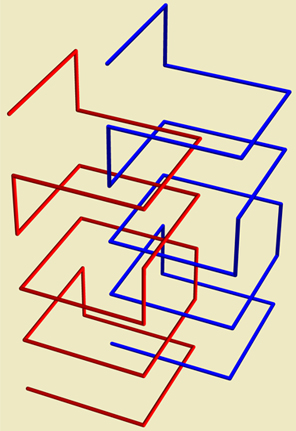I am interested in exploring the degree of "tangledness"
of two rigid chains in space.
A polygonal chain is a simple (non-self-intersecting) path
of segments in
$\mathbb{R}^3$, viewed as a rigid body. Think of it as a bent
wire in space.
Define a move of a chain as either a translation of the whole chain
in a fixed direction, or a rotation of the chain about a fixed point axis.
I.e., a translation moves each point $p$ of the chain along the path
$p(t) = p + t v$ for a fixed direction $v$ as $t$ varies from $0$ to $1$.
Say that two chains are separable if there is a sequence of moves
during which the chains never touch one another, and eventually
end up on opposite sides of a plane.
Q1. If each chain consists of $n$ segments, is there an upper bound as a function of $n$ (and independent of the geometry of the chains) on the number of moves needed to separate a separable pair?
Here is an example for which I believe $O(n)$ moves suffices to separate:

A more focussed question seeks difficult-to-untangle chains:
Q2. Is there a pair of chains that requires $\Omega(n^2)$ moves to separate?
My explorations have not led to an example that clearly requires
many moves to separate. For example, I think this pair of spirals also only
needs $O(n)$ moves.

A simplification would also be of interest:
Q3. The same questions but with "moves" restricted to translations.
Thanks for ideas or pointers to relevant literature!

